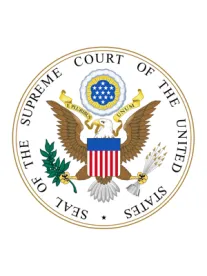Greetings, Court Fans!
It’s been a busy week at One First Street, with three opinions, a notable concurrence in a cert denial, and a pair of consequential cert grants. Let’s get you caught up to speed.
The big decision of the week was Timbs v. Indiana (No. 17-091), in which a unanimous Court held that the Eighth Amendment’s Excessive Fines Clause applies to the states, albeit with some notable disagreement about the method of incorporation.
After his father died, Tyson Timbs used some of the money he received from a life insurance policy to purchase a $42,000 Land Rover SUV. Unfortunately, in addition to transporting himself, he also used the vehicle to transport heroin for sale. When he was arrested on drug charges, the State of Indiana seized the SUV and, after he pled guilty, the State sought civil forfeiture of the vehicle on the grounds that it had been used in the course of his offense. The trial court denied the States’ request, concluding that forfeiting the $42,000 vehicle would be grossly disproportionate to the gravity of his offense in violation of the Excessive Fines Clause. The Indiana Supreme Court reversed that decision, not because it found the forfeiture to be proportionate but because it concluded that the Excessive Fines Clause (unlike the prohibitions of cruel and unusual punishment and excessive bail) had not been incorporated against the states and therefore constrained only federal action.
Well, now it is. Writing for a mostly unanimous Court, Justice Ginsburg traced the roots of the Excessive Fines Clause back to the Magna Carta and through the English Bill of Rights and colonial era state constitutions. The protection against excessive fines has been a constant throughout Anglo-American history, she noted, because such fines undermine other liberties. They can be used to retaliate against or chill the speech of political enemies, or can be employed as a source of revenue rather than in service of a penal purpose. (Though she didn’t come right out and say it, that certainly appears to have been the case in Indiana, which, along with other state and local governments often hires private law firms to aggressively pursue forfeitures on a contingency basis and depend on fines as a source of general revenue.) Because the protection provided by the Excessive Fines Clause is “fundamental to our scheme of ordered liberty, with deep roots in our history and tradition,” the Court held that it is incorporated by the Due Process Clause of the Fourteenth Amendment and applicable to the states.
That, as you may recall from law school, is the test the Supreme Court has long applied to determine whether a protection of the Bill of Rights applies to the States. But many originalists haven’t embraced that test, instead arguing that the Bill of Rights should be incorporated through the Privileges or Immunities Clause of the Fourteenth Amendment. Justice Thomas penned a lengthy opinion concurring in the judgment, explaining why. The Privileges or Immunities Clause provides that “[n]o State shall make or enforce any law which shall abridge the privileges or immunities of citizens of the United States.” As Justice Thomas has noted before, “[o]n its face, this appears to grant United States citizens a certain collection of rights—i.e., privileges or immunities—attributable to that status.” This would be the natural way of applying the Bill of Rights to the States, but for the fact that the Privileges or Immunities Clause was marginalized in Slaughterhouse Cases in the late 19th Century. The Due Process Clause, by contrast, only prohibits a State from “depriv[ing] any person of life, liberty, or property, without due process of law.” Though the Court has long recognized a substantive component to the Due Process Clause, “substantive due process” has equally long been an originalist bogeyman, leading, in Thomas’s view to “some of the Court’s most notoriously incorrect decisions. E.g. Roe v. Wade, 410 U.S. 113 (1973); Dred Scott v. Sandford, 19 How. 393, 450 (1857).” Because the Privileges or Immunities Clause protects enumerated rights without permitting as much mischief as the Due Process Clause, Thomas insisted that it was the proper means of incorporating the Excessive Fines Clause in this case.
Thomas’s concurrence echoes his separate opinion in McDonald v. City of Chicago (2010), the case that incorporated the Second Amendment against the States. Back then, Justice Scalia also wrote separately, acknowledging the force of Justice Thomas’s arguments but resigning himself to the use of the Due Process Clause to incorporate rights. This time, it was Justice Gorsuch straddling the fence. He wrote his own brief concurrence acknowledging “as an original matter,” that the “appropriate vehicle for incorporation may well be the Fourteenth Amendment’s Privileges or Immunities Clause,” but stressed that “nothing in this case turns on that question, and, regardless of the precise vehicle, there can be no serious doubt that the Fourteenth Amendment requires the States to respect the freedom from excessive fines enshrined in the Eighth Amendment.” Therefore, he joined Justice Ginsburg’s opinion in full. (Justice Kavanaugh, the other new conservative on the Court joined the majority opinion without comment.)
Next up, in Dawson v. Staeger (No. 17-419), a unanimous Supreme Court struck a blow for federal employees who want to retire in wild and wonderful West Virginia. When James Dawson retired from the U.S. Marshals Service, his home state of West Virginia began taxing his federal pension. But he soon learned that West Virginia exempted the pension benefits of retired state law enforcement officers from state income taxes. He sued, alleging that this differential treatment violated 4 U.S.C. § 111, which allows states to tax federal employees’ pay, but only if the “taxation does not discriminate against the officer or employee because of the source of the pay or compensation.” A West Virginia trial court agreed with him that there was no meaningful difference between his powers and duties as a U.S. Marshal and the powers and duties of the state law enforcement officers whose pensions were exempt from state income tax. This, the court held, was exactly what Section 111 prohibits. But the West Virginia Supreme Court reversed. It noted that only a small slice of West Virginia state employees benefited from the exemption and that he purpose of the exemption is to help this small slice of favored West Virginians, not to stick it to the Feds.
Writing for a unanimous Court, Justice Gorsuch concluded that the trial court was right. The State did not dispute the trial court’s finding that there were no significant differences between the responsibilities of a U.S. Marshal and the responsibilities of the exempted state officers. And if “discrimination” means anything, it surely means treating those who are similarly situated differently. Gorsuch rejected the State’s argument that there was no meaningful interference with the operations of federal government, given the narrow class of state employees who benefitted from the exemption. Section 111 does not care about how many people are discriminated against and it does not care whether the federal government’s purposes are hindered. It only cares about whether similarly situated folks are being treated differently. In the same vein, it did not matter that many state employees with similar responsibilities as federal marshals were also denied the exemption. What matters is whether federal employees are similar to those who are favored, not whether they are also similar to those who are disfavored. The fact that some state employees might complain they too are being treated differently without a good reason is no defense. And it did not matter that the State was not trying to harm federal retirees: Section 111 prohibits discriminatory taxes, not discriminatory animus. The State also argued that the exemption was necessary to close the gap between the meager pension benefits it was able to provide its retirees and the lavish benefits of their federal counterparts, but Justice Gorsuch called BS. If the state law were written to exempt from taxation those state employees whose pension benefits fell below a certain level, then it would be fine for the State to deny the exemption to federal employees whose benefits exceeded the threshold. But that was not how the law was drafted: It exempted certain categories of employees, defined by their job titles and responsibilities. Dawson had the same responsibilities as those employees, so denying him the same exemption was discriminatory. That his pension may be larger than that of state employees did not justify this differential treatment.
Finally, in Moore v. Texas (No. 18-443), we—and, more importantly, the Texas Court of Criminal Appeals (CCA)—learned that the Court meant what it said when it decided this same case back in 2017. In the first go-round, the Court rejected the test that the CCA used to determine whether Bobby James Moore and other death-row inmates should be spared execution due to mental disability. The Court held that the CCA’s test—known formally as the Briseno factors after a leading case, but colloquially as the “Lennie standard,” after the dim-witted character from Of Mice and Men—was improper because it relied on outdated and unscientific stereotypes. The Court remanded the case to the CCA to reconsider whether Moore was intellectually disabled for the death penalty in a manner consistent with the “medical community’s diagnostic framework.”
Well, the CCA didn’t quite get the message. On remand, the state court again sentenced Moore to death (even though the DA conceded his intellectual disability), relying on the same flawed lay opinions and stereotypes as before. This didn’t go over well with the Supreme Court. In a short and punchy per curiam decision, the Court granted cert, reversed and remanded. The CCA’s decision, the Court held, “repeat[ed] the analysis we previously found wanting.” While its decision “was not identical” to its earlier decision—there were “sentences here and there suggesting other modes of analysis”—at bottom, its opinion relied on the same lay stereotypes of the intellectually disabled that the Court had rejected in Moore. The Court vacated once again and, to avoid any shenanigans on the third go-round, it expressly “agree[d] with Moore and the prosecutor that, on the basis of the trial court record, Moore has shown he is a person with intellectual disability.”
Justices Alito, Thomas, and Gorsuch dissented, largely on the ground that they felt the Court’s previous Moore decision was wrong. The dissenters also accused the majority of making a “foray into factfinding,” which they criticized as “an unsound departure from our usual practice.”
But what is most notable about the dissent is who did not join it. The Chief Justice, despite authoring the dissent in the first Moore decision joined the majority in chastising the CCA this time. In a one-paragraph concurrence, he argued once again that the first decision “lacked clarity,” but insisted that it was not up to the CCA to disregard the Supreme Court’s mandate and “repeat[] the same errors that this Court previously condemned—if not quite in haec verba, certainly in substance.” This is the second time this month that the Chief has joined the majority in rejecting a lower court’s apparent disregard of a prior Supreme Court decision that he dissented in. Just as in June Medical Services, the Chief appears to be letting lower courts know that if Supreme Court precedent is going to be overruled or cut back, he and four other justices, not ambitious lower-court judges, will be the ones to do it.
One other opinion that got a lot of attention this week was Justice Thomas’s concurrence in the denial of certiorari in McKee v. Cosby (No. 17-1542)—and not just because of the famous defendant. The case is Kathrine McKee’s appeal of the dismissal of a defamation suit she brought against Bill Cosby. In 2014, McKee publicly accused Cosby of raping her 40 years ago. In her lawsuit, she alleged that Cosby responded by leaking a defamatory letter that distorted her background and caused damage to her reputation. The district court dismissed her defamation suit, however, because it determined that by disclosing her accusation to a reporter, McKee had become a “thrust herself to the forefront” of the public controversy over sexual assault allegations against Cosby and therefore qualified as a “limited-purpose public figure.” Applying New York Times Co. v. Sullivan, 376 U.S. 254 (1964), the lower court held that McKee could not recover damages unless she could show that the alleged defamatory statement was made with “actual malice—that is, with knowledge that it was false or with reckless disregarding of whether it was false or not.”
In her cert petition, McKee asked the Court to review her classification as a limited-purpose public figure. The Court denied cert. In a concurring opinion, Justice Thomas “agree[d] with the Court’s decision not to take up that factbound question,” but wrote “to explain why, in an appropriate case, we should reconsider the precedents that require courts to ask it in the first place,” including the seminal New York Times decision. That decision and others, Thomas argued, “were policy-driven decisions masquerading as constitutional law.” “If the Constitution does not require public figures to satisfy an actual-malice standards in state-law defamation suits,” Thomas wrote, “then neither should we.”
Needless to say, even in the absence of evident support from any other Justices, Thomas’s call to revisit New York Times was received with alarm by many in the media, particularly in the context of a President who frequently tweets that the country’s libel laws should be relaxed.
Finally, the Court granted cert in two new cases, one of which it agreed to hear this term. In Department of Commerce v. New York (No. 19-966), the Court will review the injunction entered by SDNY judge (and Wiggin alum) Jesse Furman, following a bench trial, preventing the Commerce Department from adding a question about citizenship to the 2020 census. New York and several other plaintiffs sought to block the Commerce Department from adding a citizenship question because, arguing that it was being added for a discriminatory purpose and would deter undocumented immigrants from responding, leading to an artificial depression of the official population of communities with large numbers of immigrants. Back in November, the Supreme Court agreed to review Judge Furman’s decision to order discovery outside the Administrative Record. However, it did not stay the trial in the meantime and, on January 15th, Judge Furman issued a decision enjoining the citizenship question without relying on extra-record evidence. The Supreme Court removed the case from the calendar but indicated that it could reinstate it later in the term. The Commerce Department then sought a writ of certiorari before justice—skipping the Second Circuit—to review Judge Furman’s decision on the merits. Although the Trump administration has been doing that a lot of late, in this instance it had good reason to, since the Census questions need to be finalized by the end of June. The Court has now agreed to review the decision and to grant expedited argument. In addition to the ultimate question of whether the District Court properly enjoined the addition of the citizenship question as a violation of the Administrative Procedure Act, the Court will take up the earlier evidentiary question—i.e., whether a district court may order discover outside the administrative record to probe the mental processes of an agency decisionmaker in an action to set aside agency action.
The Court also granted cert in County of Maui, Hawaii v. Hawaii Wildlife Fund (No. 18-260), a potentially important environmental case. The Court will address: (1) Whether the Clean Water Act requires a permit when pollutants originate from a point source but are conveyed to navigable waters by a nonpoint sources, such as groundwater, and (2) whether the County of Maui had fair notice that a Clean Water Act permit was required for its underground injection control wells that operated without such a permit for nearly 40 years.
That’s enough for this week. We’ll be back next week with the latest.





 />i
/>i

